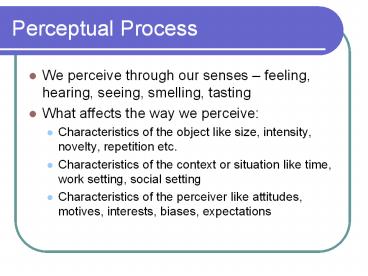Perceptual Process - PowerPoint PPT Presentation
1 / 19
Title:
Perceptual Process
Description:
Does the person respond the same way over time? If so, likely to make an internal attribution ... tends to disproportionately attribute employees' behavior to ... – PowerPoint PPT presentation
Number of Views:1075
Avg rating:3.0/5.0
Title: Perceptual Process
1
Perceptual Process
- We perceive through our senses feeling,
hearing, seeing, smelling, tasting - What affects the way we perceive
- Characteristics of the object like size,
intensity, novelty, repetition etc. - Characteristics of the context or situation like
time, work setting, social setting - Characteristics of the perceiver like attitudes,
motives, interests, biases, expectations
2
Attributions
- A perceptual process whereby observers decide
what caused the behavior of another person. - Causes of peoples behavior are said to be either
internal to the person (personality, emotions,
motives, ability) or external of the person
(other people, the situation, luck or chance).
3
Attribution Theory
- As we observe others behavior we can make either
an - Internal Attribution
- External Attribution
4
Kelleys Attribution Rules
- Consistency the extent to which the person
behaves in the same manner on other occasions
when faced with the same situations. Does the
person respond the same way over time? If so,
likely to make an internal attribution
5
Attribution Rules
- Distinctiveness the extent to which the person
acts in the same manner in different situations.
Is the behavior unusual or distinctive? If so,
likely to make an external attribution
6
Attribution Rules
- Consensus the extent to which others, faced
with the same situation, behave in manner similar
to the person perceived. Is everyone who is
faced with a similar situation responding in the
same way? If so, likely to make an external
attribution
7
Attribution Rules
- Internal Attribution is made when
- High consistency the observed person behaved
this way in the past (consistent over time) - Low distinctiveness the observed person behaves
like this in different situations - Low consensus other people dont behave this
way in this situation
8
Attribution Rules
- External Attribution is made when
- Low consistency the observed persons behavior
is not consistent over time - High distinctiveness the observed persons
behavior is unusual or distinctive - High consensus other people are behaving this
way in the same situation
9
Attribution Example 1
- You are the accounting manager at a manufacturing
plant and observe, Bob, one of your accountants,
fails to turn in this months budget report on
time. Using the attribution rules, what
questions might you ask yourself?
10
Attribution Example 1 Cont
- Have other employees also turned in their reports
late? Or, how often do other people act this way
in this situation? Consensus - Has Bob turned in other reports late or just this
one? Or, how often does he act this way
regarding other reports? Distinctiveness - Has Bob turned in this budget report late in past
months? Or, how often has he acted this way in
the past? Consistency
11
Attribution Example 1 Cont
- External Attribution Many employees were late
turning in their monthly reports (high
consensus) Bob was late turning in this report
but not other ones or he didnt act this way in
other situations (high distinctiveness) and hes
usually not late turning in this budget report or
hasnt been in the past (low consistency)
12
Attribution Example 2
- You are the manager of HR in a large firm and an
employee visits your office complaining about his
supervisors management practices and the way he
interacts with employees. You are trying to
decide whether or not the employees complaints
seem reasonable enough to investigate. Using the
Attribution rules, what questions might you ask
yourself?
13
Attribution Example 2 Cont
- Have other employees also complained? Consensus
- Does the employee complain about everything and
all supervisors or just this one?
Distinctiveness - Has this employee complained about this before or
is this the first time? Consistency
14
Attribution Example 2 Cont
- Internal Attribution No one else has complained
(low consensus) this employee complains about
everything and everyone ( low distinctiveness)
and has done so now and in the past (high
consistency)
15
Attribution Errors
- Fundamental Attribution Error
- Underestimating the impact of environmental
factors when observing undesirable behaviors.
Attributing behavior of other people to internal
factors (their motivation/ability) - Self-Serving Bias
- Attributing our successes to internal factors and
our failures to external factors
16
Other Perceptual Errors or Biases
- Selective Perception people selectively
interpret what they see on the basis of their
interests, background, experience, and attitudes - Halo Effect drawing a general impression about
an individual on the basis of a single
characteristic - Projection similar to me. Attributing ones
own characteristics to other people - Stereotyping judging someone based on your
perceptions of the group to which he or she
belongs
17
Implications of Attributions on Decision Making
- Generally speaking, management tends to
disproportionately attribute employees behavior
to internal causes - Managers tend to be more strict and often punish
employees more severely when they attribute poor
performance to a lack of effort or motivation
18
Implications Cont
- When poor performance is attributed to a lack of
ability, managers tend to propose training or
transfer rather than disciplinary actions - Employees often receive larger pay increases or
bonuses when good performance is attributed to
the employees ability rather than external
factors
19
Applications to Organizations
- Employment Interview
- Performance Appraisal
- Decision Making interpretation and evaluation
of information































